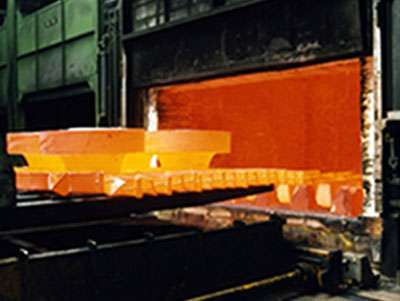Annealing is the treatment of a metal or alloy by heating to a predetermined temperature and then cooling to room temperature. Annealing improves ductility and reduces brittleness. IST anneals in a controlled atmosphere to avoid surface scaling.
Normalizing is the treatment of a metal or alloy by heating to a predetermined temperature above the material’s transformation temperature and then controlled cooling to well below the transformation range. Normalizing provides grain refinement and uniformity. IST normalizes in a controlled atmosphere to avoid surface scaling.
Stress Relieving is the treatment of a metal or alloy by heating to a predetermined temperature below its lower transformation temperature followed by cooling in air. The primary purpose is to relieve stresses that have been absorbed by the metal from processes such as forming, straightening, machining or rolling.


View all of Our ServicesRequest a Quote Today
Annealing/Normalizing/Stress Relieving Capabilities
Part Length Range
0.25 mm to 762 mm
Loading Methods
Bulk Loading
Rack Loading
Facilities
Furnace size up to 36″ x 72″ x 36″, load size up to 6000 pounds
Continuous belt systems (2)
Data log heat treat attributes
Integral pre- and post-washing systems
Slow cool in protective atmosphere
Customer Process Specifications
Caterpillar 1E1042
Chrysler PS-4
Clark Components International (5X- )
Ford W-HTX-14, W-HT1-15
Trained/Competent Workforce
To attain operational excellence, IST fosters employee development by diversifying employee’s capabilities, enhancing skill sets and creating a climate for action. Cross-trained employees understand all aspects of the heat treat process, and our customer’s needs. Certified employees are capable of receiving, heat treating, inspecting and shipping.
Technology and Knowledge Management
To best manage our customer’s needs, IST continually refines the knowledge management process and improves information technology resources. We utilize best practices to facilitate the transfer of knowledge to all levels of the organization; employees understand our customer’s requirements and act in their best interests.
 Stress relieving
Stress relieving
Stress relieving is carried out on metal products in order to minimise residual stresses in the structure thereby reducing the risk of dimensional changes during further manufacturing or final use of the component.
Benefits
Machining, and cutting, as well as plastic deformation, will cause a build up of stresses in a material. These stresses could cause unwanted dimension changes if released uncontrolled, for example during a subsequent heat treatment. To minimise stresses after machining and the risk for dimension changes the component can be stress relieved.
Stress relieving is normally done after rough machining, but before final finishing such as polishing or grinding.
Parts that have tight dimensional tolerances, and are going to be further processed, for example by nitrocarburising, must be stress relieved.
Welded structures can be made tension free by stress relieving.
Application & materials
Stress relieving does not change the material’s structure and does not significantly affect its hardness.
Hardened and tempered parts to be stress relieved must be treated at a temperature around 50°C below the temperature used for previous tempering to avoid an impact on the hardness.
Stress relieving before nitrocarburising should be executed at temperatures >600°C.
Copper and brass components can also be stress relieved. For stainless steels a high temperature solution heat treatment is normally necessary.
Process details
The stress relieving temperature is normally between 550 and 650°C for steel parts. Soaking time is about one to two hours. After the soaking time the components should be cooled down slowly in the furnace or in air. A slow cooling speed is important to avoid tensions caused by temperature differences in the material, this is especially important when stress relieving larger components.
If necessary, stress relieving can be performed in a furnace with protective gas, to protect surfaces from oxidation. In extreme conditions vacuum furnaces can be used.
The temperature for stress relieving copper parts is, depending on the alloy, 150-275°C and for brass components 250-500°C.
Metal Stress Relieving
Stress relieving is a general term in heat treating, describing a wide range of processes. Generally, metal stress relieving involves heating a part to a temperature at which the yield strength is sufficiently low to the point which internal stresses can relieve themselves. Higher temperatures and longer times are beneficial and will yield a part with lower internal stress. Temperatures are always below the point at which there is a change of phase in steel.
Process of Stress Relieving Heat Treatment – Points to Consider
Stress relieving is a heat treatment process used for materials ranging from plastics and steel to non-ferrous materials, such as copper alloys and aluminum. For non-ferrous materials, temperatures are comparatively low, ranging from about 200F for plastics and 900F for copper alloys.
- When stress relieving steel and iron, the typical temperatures range from 1000F to 1300F.
- Stress relieving steel is always done at temperatures below the range at which the austenite phase begins to form.
- When aiming for the lowest possible internal stresses, it is important that metal stress relieving is completed at temperatures at or near 1300F. This process is called sub-critical annealing because the temperatures used are near the point at which austenite begins to form.
- Metal stress relieving in an open fire furnace does cause surface oxidation, which ranges from discoloration at lower temperatures to a fine scale at sub-critical temperatures.
- If final surface finish is of concern, oxidation can be avoided by using a nitrogen atmosphere or stress relieving in a vacuum.
- There is a substantial difference in cost for these processes, so it is wise to communicate these concerns prior to industrial heat-treating services.
Stress Relieving Recommendations from ThermTech
Typically, there is very little distortion during stress relieving. However, some considerations may be required for long slender components or plates that are heavily cold worked. If shot blasting is done after stress relieving, this operation does impart compressive stresses at the surface of the material and can cause distortion. Cast materials with low ductility or with geometries that include stress risers can increase the probability of cracking during the heating portion of the stress relief cycle. These materials may need a slow ramp rate to the stress relieving temperature.
GET A FREE QUOTEMetal Stress Relieving Services
Heat Treating, Thermal Stress Relieving & Annealing Services
At Accurate Metal Products (AMP), we provide metalworking solutions to industrial customers. In addition to metal fabrication capabilities (e.g., oxy-fuel flame cutting, plasma cutting, and Laser Cutting Services), we maintain the ability to perform a range of material treatment and finishing operations so we can deliver components that fully meet the needs of our customers.
One of our heat treating service offerings is thermal stress relieving for carbon steel, and other steel alloys. The treatment is used to alleviate or eliminate internal stresses within a metal component or assembly resulting from previous manufacturing operations (e.g., cutting, forming, machining, welding, etc.). These stresses can cause distortion, fracturing, and other damage to a component if they are not properly handled.
Examples of Our Work
Heat Treating, Thermal Stress Relieving & Annealing – Capabilities
Annealing Methods Subcritical
Subcritical Anneal (500 – 1400°F) Stress Relieving Methods Standard
Standard Stress Relieve (1100 – 1200°F)
ASME Section I
ASME Section I (900 – 1300°F)
ASME Section I, PW-39
ASME Section VIII
ASME Section VIII (900 – 1300°F)
ASME Section VIII, UCS-56 Materials Carbon Steel
Stainless Steel
Alloys Part Length Up to 105″ Part Width Up to 60″ Part Weight 10,000 lbs. Lifting Capacity 5 to 10 ton Additional Services Clean
Package
Bar Coding
*Free Delivery (150 mile Radius of Milwaukee or Rockford) Production Volume Low to High Volume Lead time Inquire for current lead times
back to top
Additional Information
Industry Focus Agriculture, Automation / Production Equipment,
Construction, Mining, Nuclear, Material Handling,
Municipal/ Government, Power Generation, Rail, Wind Intended Application Components
Armor Plating
Heavy Duty Vehicle
OEM Components Industry Standards ASTM
ANSI
ASME File Formats AutoCAD (DWG, DXF)
Overview of the Stress Relieving Process
While stress relieving operations can vary slightly from project to project depending on a number of factors (e.g., material, internal stresses, and previous processing operations), they generally involve first heating and then slowly cooling the component.
- Heating. The component must be heated to a temperature high enough to lower the yield strength to the point where the internal stresses can relieve themselves. The amount of time the component is heated is a minimum of one hour or until the whole piece has reached the desired temperature.
- Cooling. After the component is fully heated, it is removed from the furnace and cooled in still air. The cooling process must be conducted at a rate slow enough to avoid the formation or introduction of thermal stresses.
Stress relieving can be performed for a variety of materials, ranging from metal to plastic and ferrous to non-ferrous. Steel stress relieving operations typically involve heating temperatures between 800 to 1,300° F.
Benefits of Stress Relieving
Stress relieving is highly beneficial for manufacturing projects. For example:
- It reduces the risk of material cracking or deforming in future heat treatment operations.
- It makes metals easier to machine after heat treatment operations.
- It improves component performance in the intended application.
- It enhances component resistance to volatile environments.
Thermal Stress Relieving Services at AMP
The metalworking experts at AMP offer thermal stress relieving capabilities for carbon steel, and various other steel alloys. We can accommodate parts up to 105 inches long x 60 inches wide x 72 inches high and between 5 to 10 tons in weight. Low-volume and high-volume runs are accepted. Free delivery is included for customers within 150 miles of our Rockford, Illinois or Milwaukee, Wisconsin facilities.
Stress Relieving Methods
Different components may require different stress relieving methods. We are equipped for the following:
- Standard
- Standard Stress Relieve (1100 – 1200° F)
- ASME Section I
- ASME Section I (900 – 1300° F)
- ASME Section I, PW-39
- ASME Section VIII
- ASME Section VIII (900 – 1300° F)
- ASME Section VIII, UCS-56
Industries Served
We provide stress relieving solutions to customers from a wide range of industries, including:
- Agriculture
- Automation / Production Equipment
- Construction
- Material Handling
- Mining
- Municipal/ Government
- Nuclear
- Power Generation
- Rail
- Wind
Intended Applications
Typical parts and products we process include:
- Armor plating
- Components
- Heavy-duty vehicles
- OEM components
Industry Standards Met
Industry standards we can meet include:
- ANSI
- ASME
- ASTM
Contact Us for Your Stress Relieving Needs
Need a stress relieving service partner for your next metalworking project? As an ISO 9001:2015-certified custom manufacturer of steel sheet and plate products, Accurate Metal Products is the ideal choice! We can deliver fully fabricated and finished components that meet your exact specifications and standards.
To learn more about our metal stress relieving capabilities and how we can help in your next project, contact us today. To discuss your project specs with one of our team members, request a quote.
back to top
Annealing and stress relieving are heat treatment processes that are both used as an intermediate step in the manufacturing process to enhance the dimensional stability and machinability of steel. While both processes reduce residual stresses inside metal parts, they have differing objectives. In this article, we’ll cover the basics of (and differences between) annealing and stress relief and share a few examples of how they are applied to some common materials.
What Is Annealing?
Annealing is three-step heat treating process that softens metal, relieves stress, and increases ductility. The process alters the physical properties of the part and is often used to return the material to its original state, removing hardness that is created as a result of working processes such as stamping, drawing, or other cold forming methods.
Annealing Process Steps
- Recovery. The first step in the annealing process, recovery restores the physical properties of the metal. Heating the material in a furnace reduces dislocations in the part structure, which is what relieves residual stress and enhances ductility.
- Recrystallization. This step corrects the plastic deformation that occurs as a result of cold working manufacturing processes. By heating the material above its recrystallization temperature, new grains are formed which take the place of deformed or elongated grains. This decreases the hardness of the material and further increases its ductility.
- Grain Growth. During this phase, the new grains that begin to form during the recrystallization stage become fully formed. The rate at which this takes place is determined by the temperature of the process.
How Is Stress Relief Different from Annealing?
Unlike annealing, stress relief does not change the chemical or mechanical properties of the material, its objective is to reduce the stress.
Depending on the desired outcome and the material, annealed parts will be heated to temperatures ranging from just below or well above the critical austenitic temperature. Annealing is also not typically performed on parts that have been hardened through heat treating, as it is used to mitigate hardness that remains in parts as a result of the manufacturing process. There are three types of annealing processes:
- Full annealing means heating the metal to a temperature where it becomes fully austenitized. It is typically conducted on some stainless steels and superalloys, in addition to other materials.
- Inter-critical annealing is carried out in within a temperature range: above the material’s lower critical temperature (where austenite starts to form) and below the upper critical temperature (where austenite is fully formed). Inter-critical annealing is performed on carbon steels, alloy steels and engineering alloys.
- Sub-crticial annealing fully remains below the critical temperature where a material begins to form austenite. It can also be conducted on carbon steels, alloy steel and engineering alloys, and is usually conducted as an intermediate step between fabrication steps.
Stress relief, however, is performed on both through-hardened and non-heat-treated steel parts. The temperature of the process depends on whether the part has been through hardened, the desired final characteristics of the part, and the specific material. For parts that have not been previously heat treated, it is best to use as high of a temperature as possible without affecting the final properties of the part. For through hardened parts, stress relief is typically done at 50°F below the tempering temperature. Here are some examples:
- For heat treated H13 steel that was tempered at 1,100°F, air stress relief can be performed at a temperature up to 1,050°F to relieve the residual stress formed as a result of heat treatment. Another common stress relieving application for this material is performed on high-pressure die casting dies as a maintenance process to relieve the stresses that form during the die’s use.
- A 4140 steel part tempered at 700°F can only stress relieve up to 650°F, otherwise you risk losing the properties imparted by the heat treatment.
- As a general rule for non-heat-treated steel, 1,250°F is a good temperature for stress relieving.
- For nonferrous materials such as aluminum, deep cryogenics are often used for stress relief instead of heat treatment.
Which Process is Right for Your Application?
Our metallurgy experts can help you evaluate the effectiveness of your heat treatment specifications if you’re unsure whether annealing or stress relieving is the right process for your parts.
Why Anneal or Stress Relieve with Paulo?
You rely on your heat treater to produce consistent results, job after job. We deliver greater consistency than other commercial heat treaters due to our precision process controls and PICS system, and we demonstrate the accuracy of your process with data and testing. If you’re looking for a partner who can improve your heat treatment results, then let’s start a conversation.




